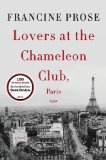Summary | Excerpt | Reading Guide | Reviews | Beyond the Book | Readalikes | Genres & Themes | Author Bio

Critics' Opinion:
Readers' Opinion:
First Published:
Apr 2014, 448 pages
Paperback:
May 2015, 448 pages
 Book Reviewed by:
Book Reviewed by:
Donna Chavez
Buy This Book
From The Devil Drives: The Life of Lou Villars
By Nathalie Dunois
Author's Preface: The Mystery of Evil
I first heard the name of Louisianne Villars whispered when I was a girl, visiting my great-aunt Suzanne Dunois, the wife and later the widow of the photographer Gabor Tsenyi. I remember hearing Lou's name and feeling a chill, as if the winter wind had blown open the door of my great-aunt's enviable Paris apartment, an old-fashioned artist's studio with whitewashed walls, leaded windows, and a collection of modernist chairs that guests, especially children, were forbidden to sit on.
For many years, all I knew was that Lou Villars was the woman in a man's tuxedo in Gabor Tsenyi's photograph "Lovers at the Chameleon Club, Paris 1932." Doubtless my readers are familiar with the portrait of the lesbian couple, the pretty girl in the sparkly gown sitting beside her broad-shouldered lover with pomaded hair and a man's pinky ring on her finger. Both stare into the middle distance, with unfocused expressions, unreadable—or so I thought, until I began my labors on this book.
I'd never understood why Lou Villars's name had so lowered the temperature in the room until I attended a 1998 show of Tsenyi's work, at the Centre Pompidou, to which I'd traveled from Rouen, where I had been living and teaching for almost twenty years.
The wall text for "Lovers at the Chameleon Club" explained that the woman in the tuxedo was a French auto racer named Louisianne Villars, who later spied for the Germans and collaborated with the Nazis. I shivered, just as I used to in my great-aunt's apartment. The chill lowered my defenses, and I caught a fever. A fever to understand. And so was planted the mutant seed that has grown into The Devil Drives, my message in a bottle.
Throughout this unexpectedly long and demanding project, it has been a source of profound exaltation and even deeper despair to immerse myself in the dramatic and terrible life of Lou Villars—a pioneer in the field of women's athletics, a woman who insisted on her right to live like a man, an international celebrity who knew everyone worth knowing, but who, because of the crimes of her later years, as well as her violent death, has completely vanished from the memory of the living. It has been a duty and a privilege to resurrect the spirit of a woman buried by a society determined that stories like hers go untold.
Even in the 1960s and 1970s, when young Frenchwomen like myself were exhuming every dead woman who ever picked up a paintbrush or conducted a science experiment or crossed a desert, everyone—even the female athletes entering the doors that Lou Villars kicked open for them decades before—even those women chose to let Lou remain forgotten in her unquiet, unmarked grave, possibly even a landfill.
The story of the writing of this book is a tale of unanswered doorbells and letters, of phone connections gone dead, of records mysteriously vanished from libraries and archives. And what other explanation can there be for these roadblocks and silences than our nation's sensitivity about its World War II record—its willful erasure of the shameful truth about our historic past?
How different this book would be if I'd had just one hour to sit down with Lou Villars and ask her, woman to woman, face-to-face: Who were you? What made you do what you did?
What I wouldn't give to speak with the people who knew her, to ask the living and the dead how one woman could have done so much harm: Gabor Tsenyi, whose art immortalized her; his patron, the baroness Lily de Rossignol, who hired Lou to race her family's cars; Eva "Yvonne" Nagy, who ran the famous Chameleon Club, where Lou got her start; Lionel Maine, the woman-hating blowhard American cult writer whom my feminist sisters have unsuccessfully tried to exorcise from the canon; the German auto racer Inge Wallser, who broke Lou's heart; Jean-Claude Bonnet, the infamous collaborator who destroyed so many innocent lives during the Occupation. Or for that matter my great-aunt, whose contact with Lou ranged from the friendly to the sadistic.
Excerpted from Lovers at the Chameleon Club, Paris 1932 by Francine Prose Copyright © 2014 by Francine Prose. Reprinted courtesy of Harper, an imprint of HarperCollins Publishers.





The Flower Sisters
by Michelle Collins Anderson
From the new Fannie Flagg of the Ozarks, a richly-woven story of family, forgiveness, and reinvention.

The House on Biscayne Bay
by Chanel Cleeton
As death stalks a gothic mansion in Miami, the lives of two women intertwine as the past and present collide.

The Funeral Cryer by Wenyan Lu
Debut novelist Wenyan Lu brings us this witty yet profound story about one woman's midlife reawakening in contemporary rural China.
Your guide toexceptional books
BookBrowse seeks out and recommends the best in contemporary fiction and nonfiction—books that not only engage and entertain but also deepen our understanding of ourselves and the world around us.